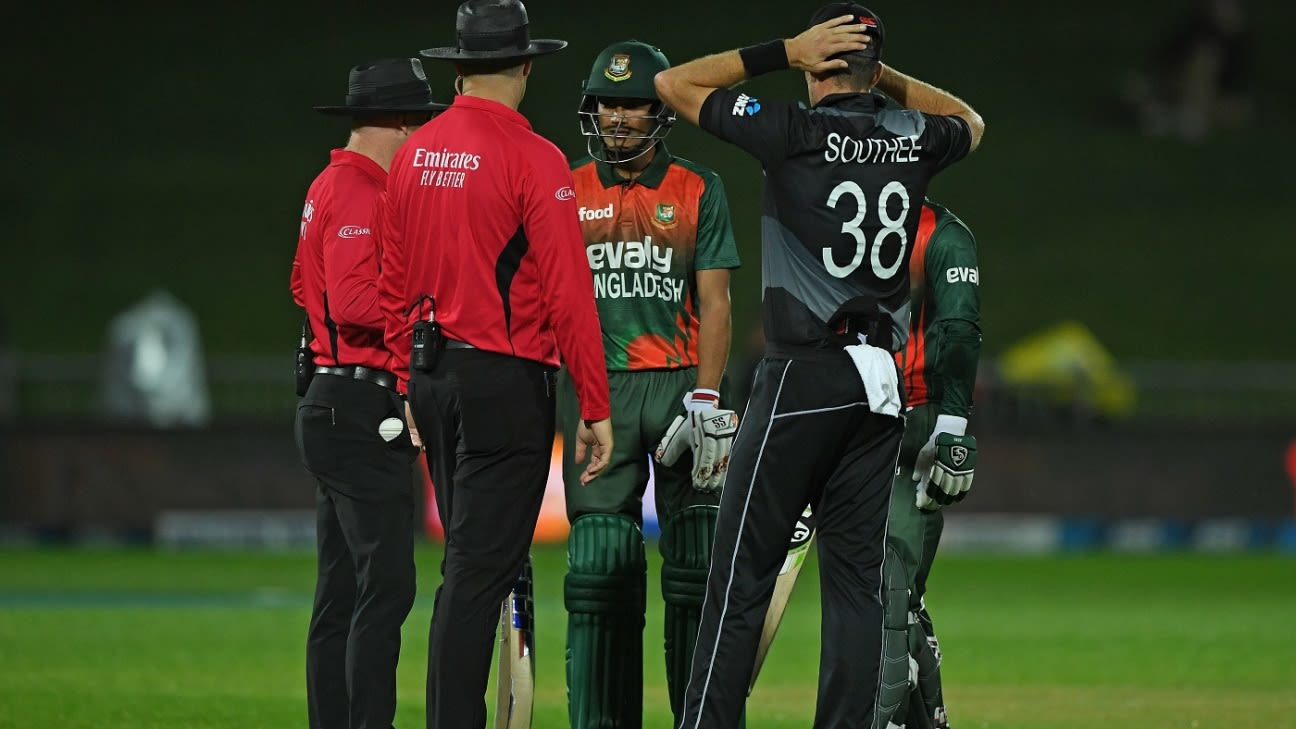
An ICC spokesperson said, “there was an operational issue at the ground” during the chase
Match officials had to stop play in unprecedented circumstances soon after Bangladesh began their chase in the second T20I in Napier, as they were unsure what the actual target was. Play stopped for several minutes nine balls into Bangladesh’s innings against New Zealand because even then it wasn’t clear whether their revised target was 148, 170 or 171.
New Zealand had been forced off the field by rain after batting 17.5 overs, in which they had scored 173 for 5. Bangladesh then batted the first nine balls of their innings – in steady rain – apparently in the knowledge that their target in 16 overs was 148; that was the target that had been flashed on the scoreboard at McLean Park. The two teams were then told by the umpires the target was 170. That target, too, was later correctly revised to 171 after the 13th over of the chase. Bangladesh eventually finished on 142 for 7 in their allotted 16 overs, falling 28 short according to the DLS method.
“There was an operational issue at the ground, which meant the DLS sheet could not be handed over to the teams,” an ICC spokesperson told ESPNcricinfo. “The target score was verbally communicated to the umpires at the start of the innings. However, play had to be halted after 1.3 overs as the teams requested for the DLS sheet to know the targets at different points during the innings. Play was resumed once the DLS sheets were provided to the teams.”
It isn’t clear yet what the operational issue was, though there appears to have been a mix-up in the DLS sheet that was handed to match referee Jeff Crowe. He is said to have recognised the target on that sheet was incorrect and asked for the correct version. What is clear, however, as Bangladesh coach Russell Domingo said later, is that the teams should not have gone out on the field without updated DLS sheets in their hand.
That has been acknowledged by match officials and it is believed Crowe has since apologised to both teams for it. Neither did it help matters that the ground scoreboard showed the over-by-over par score according to the calculation that New Zealand had batted 20 overs, not 17.5. Had New Zealand batted 20 overs and posted the same score, the target would have been 148 in 16 overs.
Play is set to start at 9-40pm NZT with Bangladesh to have 16 overs. 148 their target. Follow play LIVE with @sparknzsport in NZ #NZvBAN pic.twitter.com/IRkcJ6xjlW
— BLACKCAPS (@BLACKCAPS) March 30, 2021
Domingo and Bangladesh manager Sabbir Khan were spotted in Crowe’s room at the start of the second over of the chase. Following those conversations, which involved fourth umpire Shaun Haig, the target was revised, briefly, to 170.
“I don’t think I have been involved in a game before where batters go out and don’t know what the DLS target is,” Domingo said. “There was a lot of rain around. Nobody had any idea of how many we needed after five or six overs. I don’t think the game should have started until it was finalised, before there was a clear indication of what is required, and what we needed at certain stages. I don’t quite think it [the conduct of the match] was good enough this evening.
“[When we met the match referee] they were still waiting for the printouts and calculations to take place. I think if you are waiting, the game can’t start before you get it. What was explained now was that they normally get it one or two balls into the innings, but hadn’t received it yet. They were waiting for it. There were delays and all sorts of stuff. No excuses [for the defeat], but this is just very frustrating for us.
“They couldn’t delay the game much longer, because they were running out of overs.”
Right and now we can play. 170 confirmed as what Bangladesh will need to win from 16 overs. Play returns at McLean Park. #NZvBAN pic.twitter.com/dIz2XWpNR7
— BLACKCAPS (@BLACKCAPS) March 30, 2021
The game resumed, but even 170 wasn’t the right figure. Based on the DLS version 4.0 released last October, the target should actually have been 171, with 170 the par score for Bangladesh. It took 13 overs of the Bangladesh chase, by which stage they had ridden Soumya Sarkar’s 27-ball 51 to get to 94 for 1 in ten overs before losing a clutch of wickets in a rush, for the correct target to be flashed on the broadcast screens.
There was a fair bit of confusion in the Bangladesh dressing room when the chase began.
“I don’t think a team fields for that long in that much rain,” Domingo said, also questioning the conditions in which the game was played. “It was slippery. The ball was wet. No excuses but it all seemed to be stacked against us this evening in terms of the conditions. I have never seen a game starting in rain when we came out for four or five overs. I don’t think the rules have changed but I was under the impression the covers don’t come off until rain stops.
“The first ball can’t be bowled until the rain stops. Maybe the rules have changed. I am not too sure.”
Mohammad Isam is ESPNcricinfo’s Bangladesh correspondent. @isam84
